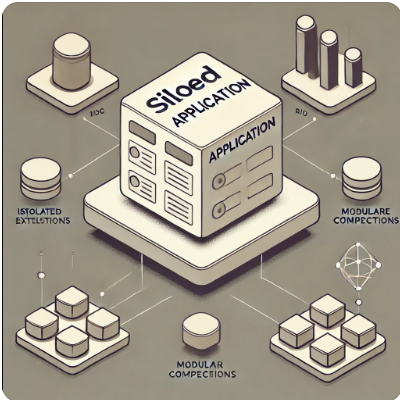
|

|

|

|
In today’s fast-evolving digital landscape, platforms represent the cornerstone of innovation and scalability. Unlike siloed applications, which are rigid and limited by their design, platforms are inherently modular and extensible. This flexibility allows organizations to adapt, innovate, and scale seamlessly, making platforms a superior choice for building systems that endure and thrive in an ever-changing technological environment.
At the heart of any platform lies modularity. Platforms are designed as ecosystems of interconnected components, where each module serves a specific function and can be upgraded or replaced independently. This modular architecture encourages experimentation and iteration, allowing developers to implement new features without disrupting the entire system. For example, a data platform might integrate seamlessly with an AI module to enable predictive analytics, or a cloud platform might host multiple applications, each with its unique capabilities. By leveraging modularity, platforms enable organizations to assemble solutions that perfectly fit their needs.
One of the most transformative aspects of platforms is their extensibility. With APIs, plugins, and third-party integrations, platforms are not confined to their initial functionality. Instead, they can evolve by incorporating external tools, services, and capabilities. This adaptability ensures that platforms remain relevant over time. A cloud computing platform, for instance, can integrate cutting-edge AI tools as they emerge, enabling businesses to stay competitive without requiring a complete system overhaul. Extensibility turns platforms into living ecosystems, where innovation thrives, and boundaries are constantly pushed.
In contrast to siloed applications, which often become obsolete as requirements change, platforms are built to evolve. They provide a foundation that can adapt to future demands, whether through new integrations, expanded capabilities, or enhanced performance. This future-proofing ensures that investments in platforms yield long-term value. Organizations are no longer shackled to legacy systems but empowered by dynamic infrastructures that grow alongside their ambitions.
The limitations of siloed applications are stark. These isolated systems often lack the ability to communicate or integrate, leading to inefficiencies and missed opportunities for synergy. Platforms, on the other hand, foster interoperability and collaboration. When platforms from different domains—such as cloud infrastructure, AI, and data management—work together, the result is a system that is far more powerful than the sum of its parts. This synergy unlocks new possibilities, such as real-time data-driven decision-making or automated workflows that span multiple domains.
The shift from siloed applications to extensible platforms marks a fundamental transformation in how we approach technology. Platforms empower organizations to build systems that are not only robust and scalable but also agile and forward-looking. They embrace change and uncertainty, providing the tools to adapt and thrive.
The power of platforms lies in their ability to turn complexity into opportunity, silos into ecosystems, and limitations into endless possibilities.